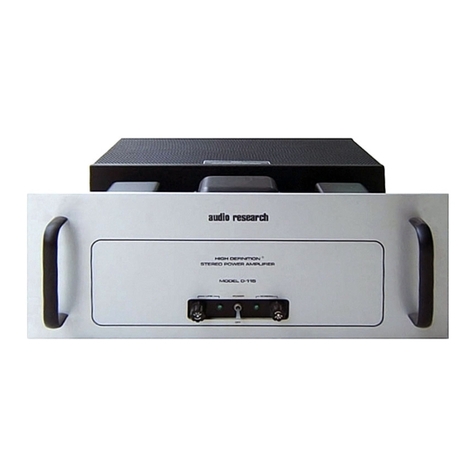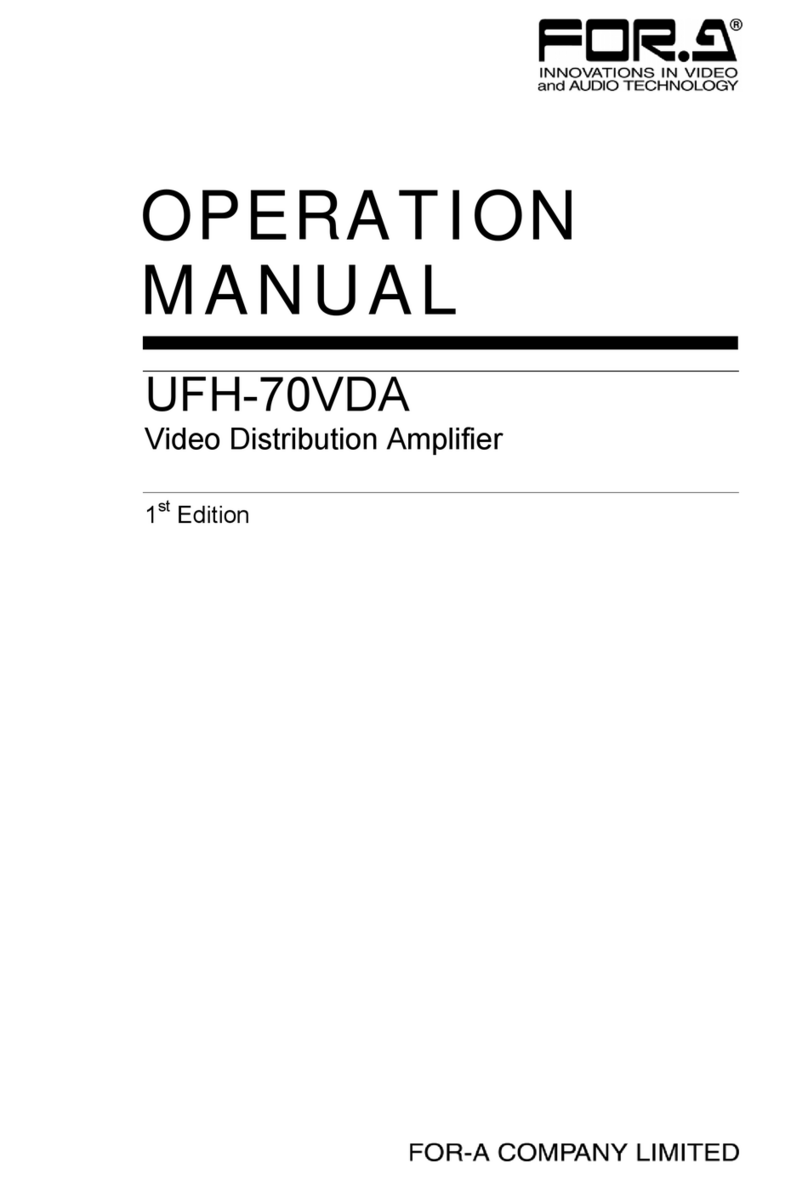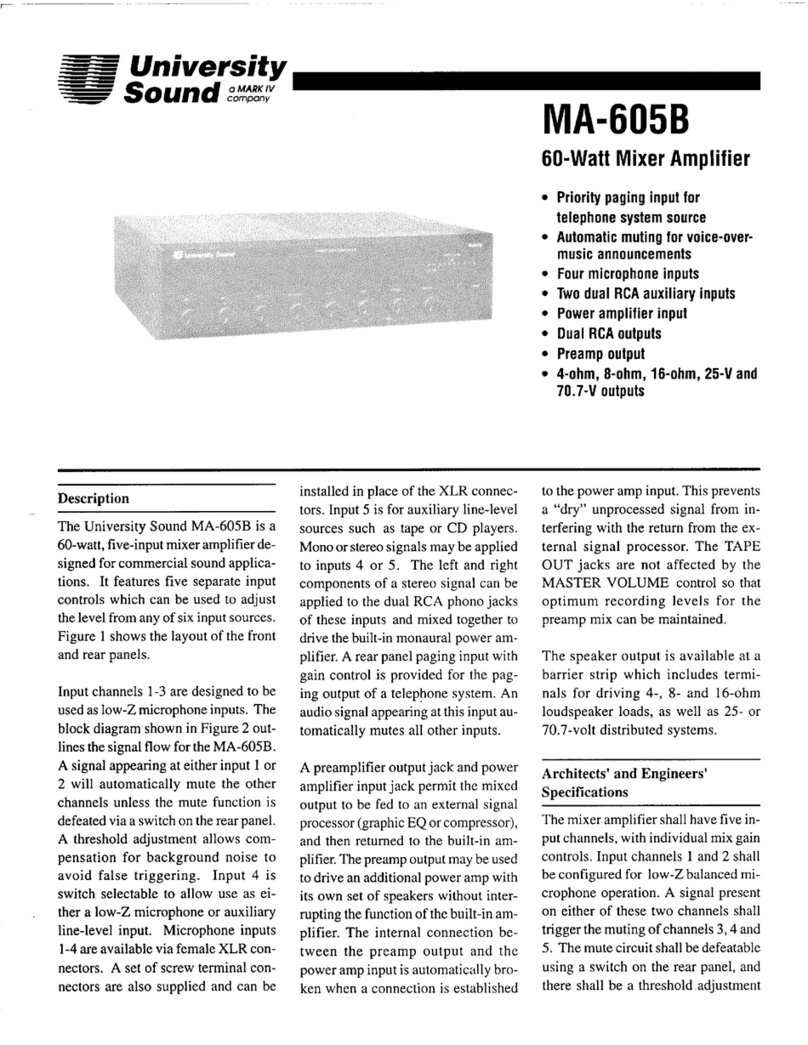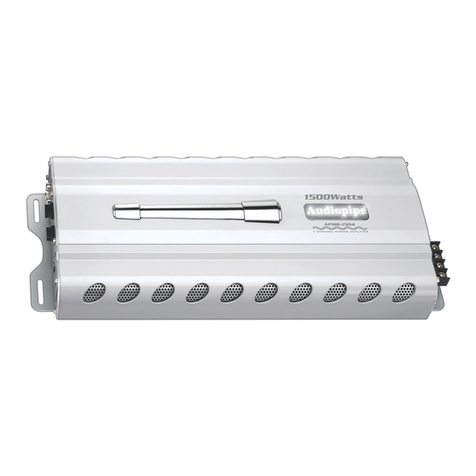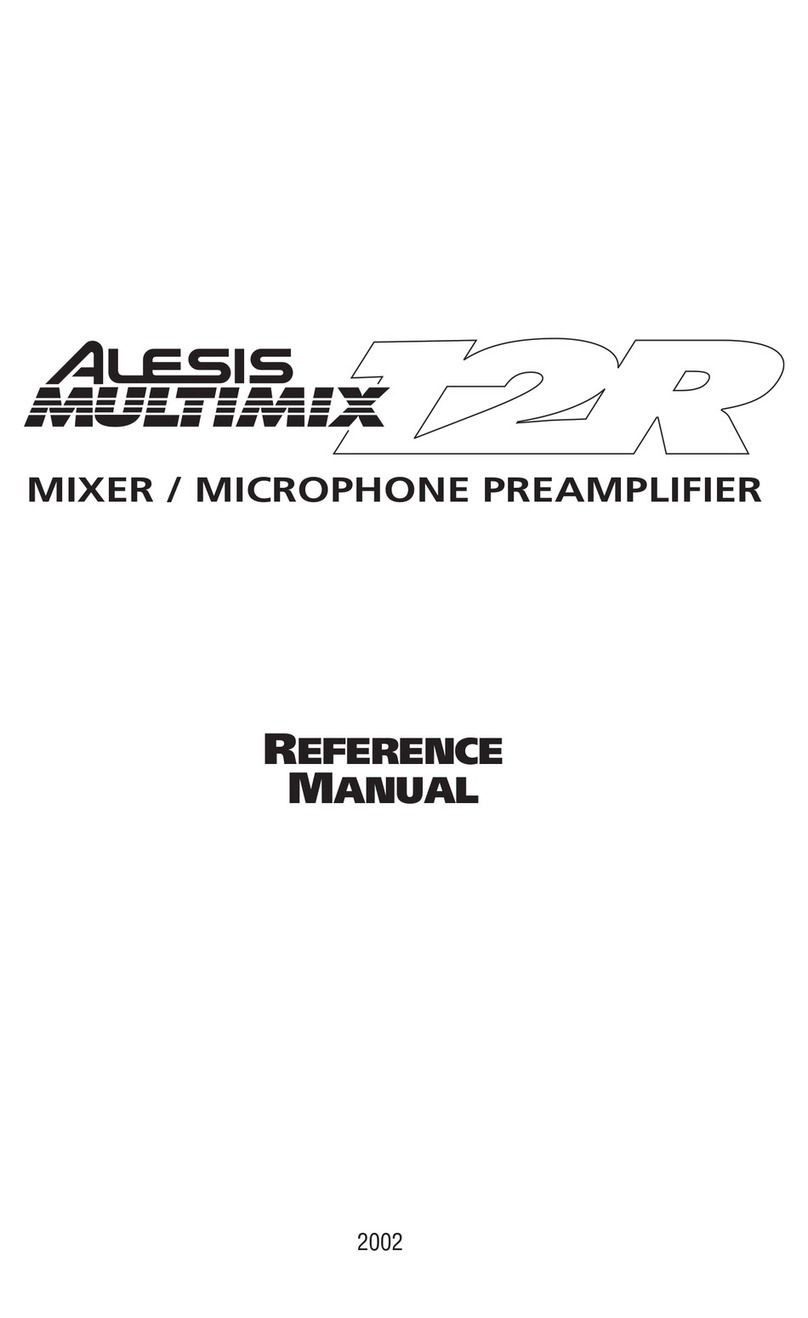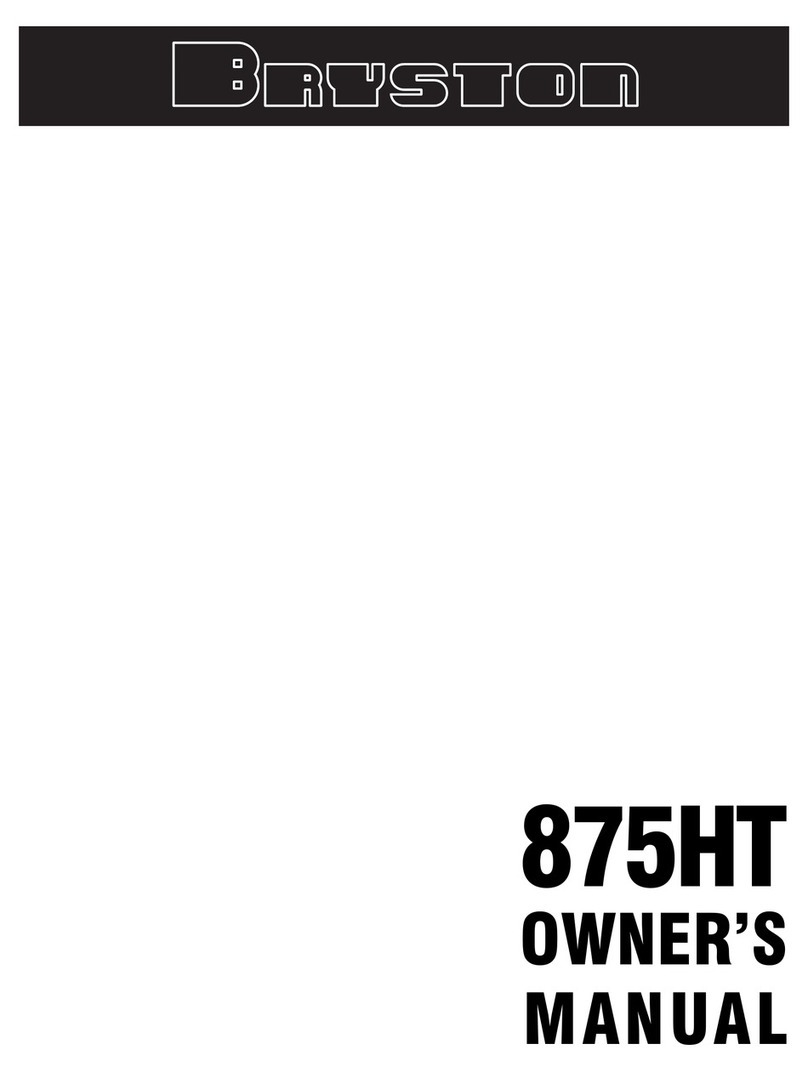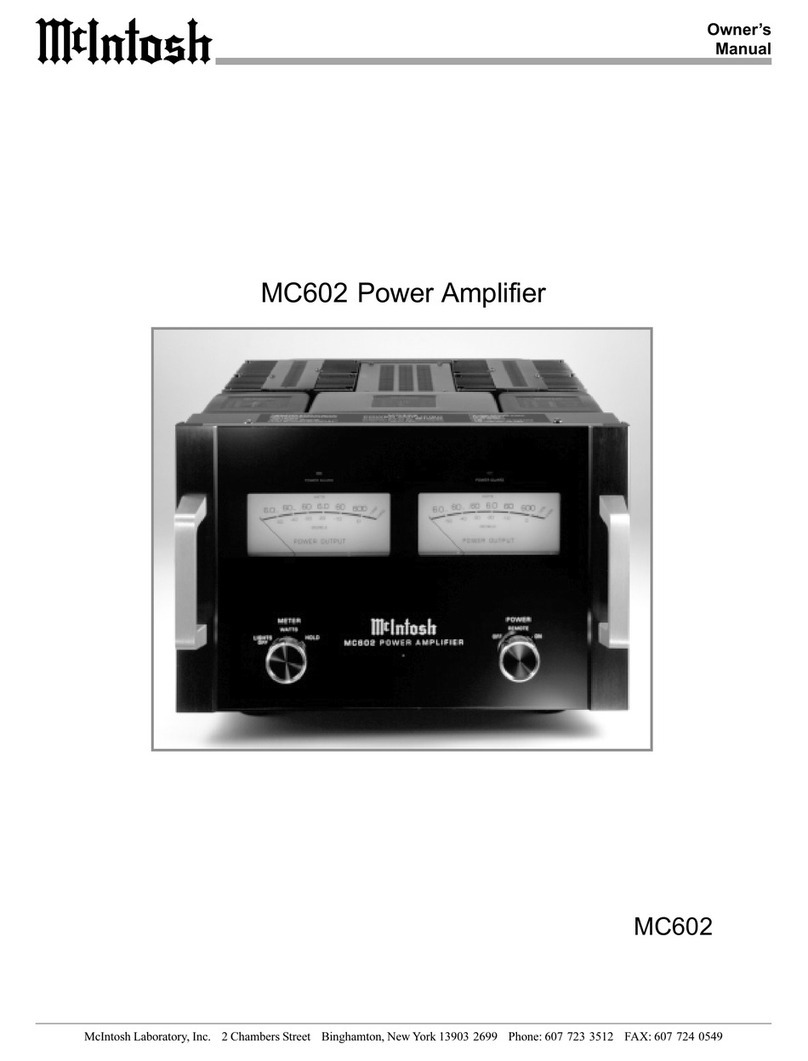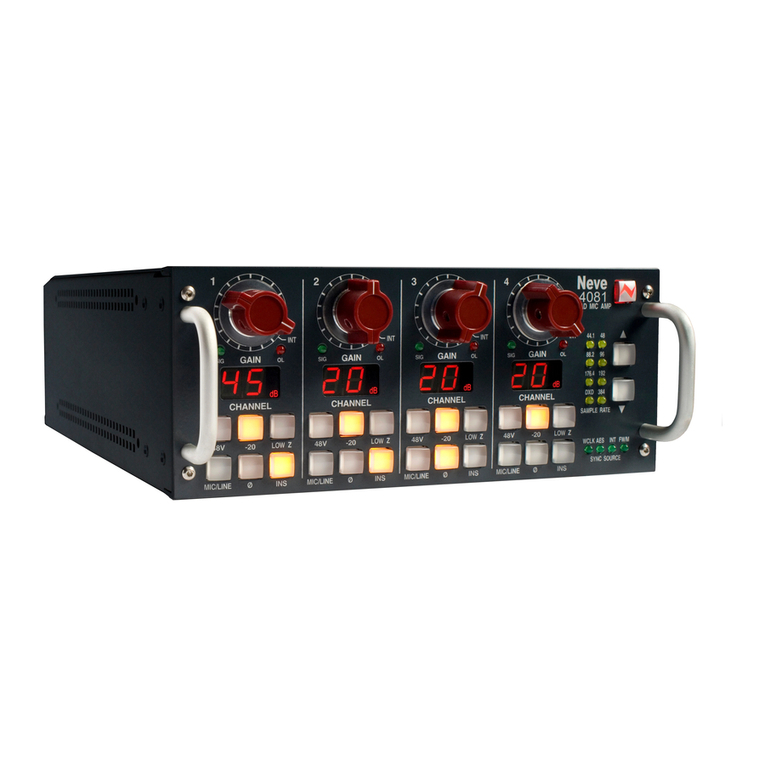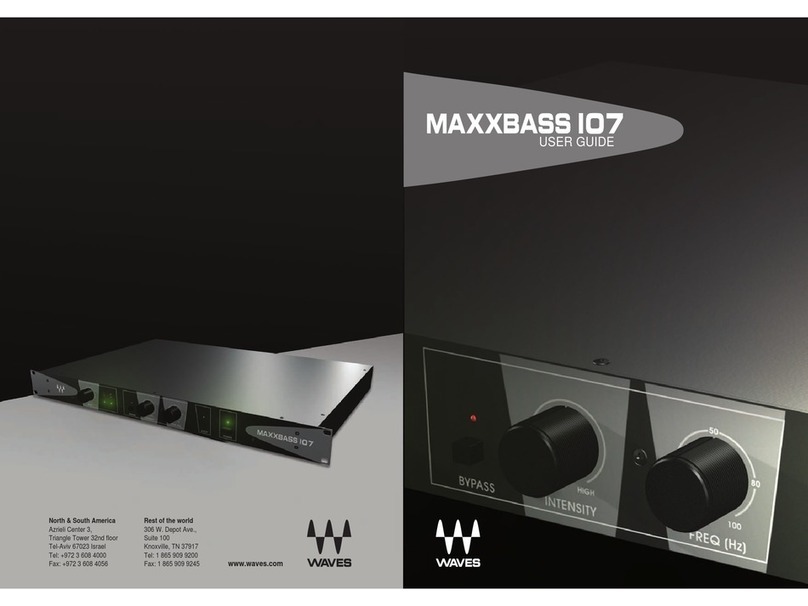Lindemann 830 User manual

830
Stereo Control Amplifi er
Owner’s Manual
ENGLISH

830 Stereo Control Amplifier
Important Safety Precautions
•Use only an approved power cable and plug or distribution board to connect your
amplifier to a power outlet. Do not use an extension cable.
•Never touch the mains plug if your hands are wet.
•Do not attempt to open the equipment. Refer servicing and repair to qualified
service personnel. Touching live components inside the case can result in a fatal
electrical shock!
•Read the Owner's Manual and Safety Precautions before operating the equipment.
•Keep this Manual in a safe place so that you can refer to it later.
•Please heed all warnings on the equipment itself and in the Owner's Manual.
•Please follow the instructions contained in your Owner's manual and never use this
equipment for any purpose other than is explained in this Owner's Manual.
•Only connect this equipment to a power source of the type described in the Owner's
Manual and specified for this equipment.
•Make sure that there is adequate ventilation around the equipment to allow proper
cooling. Keep the equipment away from direct sunlight. Avoid installing the unit
close to sources of heat or in spaces such as bookshelves or cupboards where heat
radiation may be obstructed. Avoid excessive temperatures in the room, as these
could ultimately damage sensitive components and reduce the service life of your
player.
•Never use the unit in damp rooms, at temperatures of below 15°C, or in the open air.
When bringing your amplifier in from the cold, allow it time to achieve room
temperature before plugging it in.
•Always switch the unit off before removing or inserting interconnects. Doing this
with the amplifier switched on can damage not only the amplifier itself but also
equipment connected to it.
•If you ever spill water or any other liquid onto the equipment: Do not touch the case!
Remove the plug from the wall outlet and contact your dealer or our service
department.
•Never remove the earth connection from the plug. It is there to ensure your safety.
•Arrange the power cable so that no one can accidentally stand on it. Avoid locating it
under objects that might put pressure on the cable. Pay particular attention to areas
where the cable exits from plugs, AC outlets and from the unit itself.
•Never operate the unit without being present. Disconnect the plug from the wall
outlet and remove all aerial connections (including cable aerials) when: you clean
the unit, you do not expect to use the unit for long periods of time, during an
electrical storm.
•If you have an external antenna or cable antenna connected to your hi-fi system, we
recommend that you use a signal isolating filter to avoid interference or damage
during thunderstorms.
•Problems: If you lose the sound while the amplifier is operating, or if you notice
smoke or burning, switch the unit off immediately and contact your dealer or our
service department.
•Only replace defective fuses after you have traced and removed the cause of the
fault and then only with a fuse of the same rating. Remove the mains plug before
changing fuses. Use an insulated screwdriver to remove and replace the fuse.
2

830 Stereo Control Amplifier
Dear Music Lover,
Congratulations on becoming the owner of this new Control Amplifier. The 830
is an exclusive high-end audio component, built in Germany in limited
quantities.
Our team designed this control amplifier to the highest standards so that you
could enjoy the highest level of audio reproduction. Because we use only the
finest components and the most modern production technologies, we
confidently guarantee that our products will retain their superb qualities for
many years.
Keep the carton and packaging materials that your 830 came in. They will protect
your control amplifier should you need to transport it in the future. Transporting
the 830 in anything other than the original packaging may result in physical
damage not covered by your warranty.
A final note: Please take the time to read this Owner's Manual before using the
equipment for the first time. It contains a number of useful tips gathered from
our many years of experience, which will help you get the most from your hi-fi
system.
Copyright and trade mark acknowledgements
This manual is provided for informational use only. Its content is subject to
change without notice and should not be construed as a commitment on the
part of Lindemann audiotechnik GmbH. The publisher assumes no responsibility
or liability for any errors or inaccuracies that may appear in this manual.
Copyright and trademark information
Copyright © 2006 Lindemann audiotechnik GmbH. All rights reserved.
No part of this publication may be reproduced, stored in a retrieval system or
transmitted, in any form or by any means, electronic, mechanical or otherwise,
without the prior written permission of the publisher.
3

830 Stereo Control Amplifier
Table of Contents
Copyright and trade mark acknowledgements 3
Accessories supplied 4
Front view 6
Rear view 8
Remote control 11
Using the 830 for the first time 12
Basic preamplifier controls 13
Switching on and off 13
Input select 13
Adjusting the volume 14
Balance 14
Mute 14
Configuration menu 15
Balance 16
Monitor 16
Record 16
Outputs 16
Volume display 17
Max. volume 17
Mute level 17
Absolute phase 17
Display brightness 17
Reset to default (factory settings) 17
Inputs 18
Name (input name) 18
Enable (activating inputs) 18
Gain (input sensitivity) 18
Coupling (DC filter) 18
Phase 19
Fix to 0dB (bypass) 19
Link Mode 19
Troubleshooting 21
Specification 22
CE declaration of conformity 23
Guarantee and Service 24
Directive on waste electrical and electronic equipment 25
Accessories supplied
•830 Stereo Control Amplifier
•Power cable, 2 metre
•SYSCOM cable, 1 metre
•Owner's Manual
We recommend that you keep the packaging for use when transporting the 830 in the future.
4

830 Stereo Control Amplifier
•Place your control amplifier on a stable support and use a spirit level to make
sure it is perfectly level. We recommend the use of a solidly constructed hi-fi
rack with adjustable shelves. In our experience, you will achieve good results
with racks using MDF shelves. Glass, metal or stone are less suitable for use as
hi-fi equipment supports. Avoid placing the control amplifier close to
loudspeakers or any other source of vibration. The 830 will respond to these
measures by performing at its best. Never stack the 830 directly on other
items of equipment. Vibrations from mains transformers and
electromagnetic interference from other components can have a negative
impact on the control amplifier’s sound quality. 800 series products are not
suitable for installation in enclosures such as 19” racks or cabinets. The on/off
switch at the rear of the unit must always be accessible.
•Take some time to organize your cabling. Try to keep power cables away
from interconnect and speaker cables. Shielded power cords can significantly
reduce the transfer of interference to your signal cables.
•Make sure that the polarity of the mains wiring is the same for all system
components. You can achieve this by connecting all system components
through a single high quality mains distribution board. The lower the
contact resistance between the power outlets of your signal source and your
control amplifier, the less the audio signal will be polluted and the better
your hi-fi system will sound. Connecting your components with the correct
mains polarity is particularly important. Use a phase tester to determine
which pole is life. Mark the appropriate side.
•Cleaning and maintenance: To clean your control amplifier, use a soft cloth.
Use a proprietary glass cleaner to remove stubborn dirt from the front panel.
Do not use water! Never use solvents or white spirit. These will cause
irreparable damage to the surface of the unit.
5

830 Stereo Control Amplifier
6
Front viewFront view
1 2 456 7 8 93
1. Input selector1. Input selector
2. Power2. Power
3. Standby LED3. Standby LED
4. Setup4. Setup
5. Enter5. Enter
6. Monitor6. Monitor
7. Balance7. Balance
8. Mute8. Mute
9. Volume control9. Volume control
Input selectorInput selector
Turn this knob to select the source you require. The operation of the input
selector is described in more detail under Basic preampifier controls - Input
selector.
Turn this knob to select the source you require. The operation of the input
selector is described in more detail under Basic preampifier controls - Input
selector.
The input selector is the equivalent of the LEFT/RIGHT buttons on the remote
control.
The input selector is the equivalent of the LEFT/RIGHT buttons on the remote
control.
PowerPower
Press the POWER button to turn the unit on and off. The 830 must be connected
to the mains, with the power switch on the rear panel in the 'on' position
(position I).
Press the POWER button to turn the unit on and off. The 830 must be connected
to the mains, with the power switch on the rear panel in the 'on' position
(position I).
6

830 Stereo Control Amplifier
Standby LED
When you switch the 830 on using the power switch on the rear panel, the unit
initially enters its standby mode and the standby LED illuminates. As soon as the
830 is ready for use, the standby LED extinguishes and the display becomes
active. When you switch the preamplifier off, the LED flashes for approximately 5
seconds, during which time you cannot switch the unit back on again.
Setup
This button opens the configuration menu and provides access to the more
advanced preamplifier functions. To quit, press the SETUP button repeatedly
until the standard display reappears.
Enter
Confirms your input. This is the equivalent of the OK button on the remote
control.
Monitor
This button activates and deactivates the monitor circuit.
Configuring the tape monitor loop is described under Configuration menus -
Monitor.
Balance
Direct adjustment of the balance menu. To quit the balance menu, press the
BALANCE button a second time.
You will find a description of how to adjust the balance in Configuration menus
– Balance.
Mute
Direct selection of the mute function. To cancel muting, press the MUTE a second
time, or alter the volume.
Volume control
The volume control knob adjusts the listening volume. Turning the knob
clockwise increases the volume.
The volume control is the equivalent of the UP/DOWN buttons on the remote
control.
7

830 Stereo Control Amplifier
8
Rear viewRear view
12 13 14 15 16 17 18 19
1 2 3 4 5 6 7 8 9 10 11
11. Analog output 2 XLR left
12. USB port (for updates only)
13. MONITOR output right
14. 820 Analog Supply (for 820 D/A converter)
15. SYSCOM
16. Phono Analog Supply
17. Power (on/off) switch
18. MONITOR output left
19. AC power socket
1. Analog output 2 XLR right
2. Analog output 1 XLR right
3. RECORD output right
4. Inputs 4-6 RCA right
5. Inputs 1-3 XLR right
6. Phono ground
7. Inputs 1-3 XLR left
8. Inputs 4-6 RCA left
9. RECORD output left
10. Analog output 1 XLR left
Analog inputsAnalog inputs
The 830 is equipped with both balanced (XLR) and unbalanced (RCA phono)
analog inputs. Connect the outputs from your source equipment to the
appropriate inputs on your preamplifier.
The 830 is equipped with both balanced (XLR) and unbalanced (RCA phono)
analog inputs. Connect the outputs from your source equipment to the
appropriate inputs on your preamplifier.
Make sure that the plugs are a snug fit! Poorly fitting RCA plugs can detract
considerably from the sound quality of your hi-fi system. Use gold-plated plugs
whenever possible, as these have the lowest contact resistance.
Make sure that the plugs are a snug fit! Poorly fitting RCA plugs can detract
considerably from the sound quality of your hi-fi system. Use gold-plated plugs
whenever possible, as these have the lowest contact resistance.
Pin 3: Signal -
Pin 2: Signal +
Pin 1: Ground
8

830 Stereo Control Amplifier
9
Analog outputsAnalog outputs
You can activate or deactivate both pairs of balanced outputs independently via
the "Output" settings in AMP setup. You can also adjust the level of Output 2
relative to the level of Output 1 in 0.5dB steps by up to ± 10dB.
You can activate or deactivate both pairs of balanced outputs independently via
the "Output" settings in AMP setup. You can also adjust the level of Output 2
relative to the level of Output 1 in 0.5dB steps by up to ± 10dB.
This adjustment allows you to fine tune bass frequencies relative to mid/high
frequencies in a bi-amped system, or to adjust the level of a subwoofer.
This adjustment allows you to fine tune bass frequencies relative to mid/high
frequencies in a bi-amped system, or to adjust the level of a subwoofer.
Pin 3: Signal -
Pin 2: Signal +
Pin 1: Ground
Record output
The record output enables you to send the currently active input to a tape
recorder or the soundcard of your PC. The record output signal is the same level
as the input signal.
Record out must be activated via the configuration menu.
Monitor output
The 830 is equipped with a tape loop for off-tape monitoring during recording or
for inserting an external loudspeaker equalizer. Input 6 is the tape monitor input.
Please see Configuration menus - Monitor for more details.
Phono ground
Provides an external (technical) ground, which can be used, for example, to
connect a turntable's ground lead. The ground is connected internally to the
chassis ground and to power cord's ground conductor.
Power connection
The power socket accepts standard IEC power connectors only. We recommend
you use a high quality, audiophile power cord. Your dealer will be happy to
advise you.
Power switch
The power switch fully disconnects the 830 from the AC mains supply.
9

830 Stereo Control Amplifier
SYSCOM
SYSCOM allows you to network several 800 Series components (Link mode). It
provides central control of switch-on and the display functions and allows the
system preamplifier to access the digital inputs on the 820 CD/SACD player. To
use this facility, you must be using the appropriate power amplifiers or CD/SACD
player. Please ensure that all system components are switched off before
changing any SYSCOM connections. Use only the SYSCOM cables supplied. Do
not use any other type of cable, as this could damage your equipment! If you
need longer SYSCOM cables, please contact Lindemann audiotechnik directly
(see back page for contact details) or your dealer. You will find a detailed
description of all Link Mode functions in the Link Mode section of this manual.
820 analog supply
This 15-pole SUB D port supplies power to the D/A converter in the 820 SACD
player and must not be used for any other purpose. Make sure both components
are switched off before attempting to connect this port to the 820 SACD player.
The power supply built into the 830 replaces the 800 Analog Filter Supply
normally used with the 820.
Phono analog supply
The 830 is equipped with a power supply for the optional fully balanced phono
preamplifier. Only connect the phono preamplifier to the 830 when the 830 is
switched off. The phono preamplifier should be connected to Input 1.
10

830 Stereo Control Amplifier
Remote control
1
2
3
4
5
1. Power button
Switches the unit on and off from standby.
2. Menu selection
Selects the preamplifier's configuration menu.
3. Mute
Reduces the level of the outputs to zero.
4. Navigation cluster
Normal operation:
UP/DOWN: Volume adjustment +/-
LEFT/RIGHT: Input selection
OK: Confirms your selection
Menu selection:
UP/DOWN/LEFT/RIGHT: Selects menu items
OK: Confirms your selection
5. Info
Press the INFO button to see all the important basic settings in
the alpha-numeric display.
When using the remote control, always point it directly at the
Control Amplifier. Please remember that direct sunlight or
artificial light (particularly fluorescent lighting) can affect the
signal.
If you notice a decrease in the range of the remote control, this
is normally a sign that the batteries are weak. Always replace
batteries with new ones of the same type.
To change the batteries, open the battery compartment cover
on the rear of the remote handset. Take out the discharged
batteries and replace them with new ones of the same type
(Alkaline AAA), making sure that they are positioned as shown
on the drawing in the battery compartment.
Please dispose of your used batteries carefully. Stores that sell
batteries should provide containers for the collection of used
batteries. You can also dispose of them at your nearest
recycling centre.
11

830 Stereo Control Amplifier
Using the 830 for the first time
•Turn the power switch (on the rear panel) to its off position.
•Connect the control amplifier to a wall outlet using a high quality power cord
if possible. The cable supplied is for test purposes only. We strongly
recommend that you use a high quality power cable. Make sure that the
voltage shown on the model identification plate matches the voltage of your
mains supply. If you intend to swap interconnects at any time in the future,
always remember to switch the control amplifier off first. Failure to do so
could damage the unit.
•For safety reasons, the remote control is supplied without the batteries
installed. Please insert the batteries supplied, observing the polarity marks
shown on the battery compartment.
•We have provided controls on the front panel to allow you to access the
important control functions of the 830. The remote control allows you to
access these and all the other functions of the unit.
•Switch on the unit using the power switch on the rear panel. Your control
amplifier is now in standby mode and ready for use. This is indicated by the
blue Standby LED.
12

830 Stereo Control Amplifier
13
Basic preamplifier controlsBasic preamplifier controls
Switching on and offSwitching on and off
To switch the unit on, press the POWER button on the front panel or on the
remote control.
To switch the unit on, press the POWER button on the front panel or on the
remote control.
To switch the control amplifier off, press the POWER button a second time. This
will switch the unit into standby mode. You will see the message: Power Down...
in the display.
To switch the control amplifier off, press the POWER button a second time. This
will switch the unit into standby mode. You will see the message: Power Down...
in the display.
After a short interval this will disappear and the blue standby LED will flash for
about 5 seconds. It is not possible to switch the component on again during this
time.
After a short interval this will disappear and the blue standby LED will flash for
about 5 seconds. It is not possible to switch the component on again during this
time.
Use the POWER button to switch the unit on and off in everyday use. If the
control amplifier is connected to a Lindemann power amplifier and/or CD player,
the power amplifier and/or CD player will be powered up and down at the same
time as the preamplifier.
Use the POWER button to switch the unit on and off in everyday use. If the
control amplifier is connected to a Lindemann power amplifier and/or CD player,
the power amplifier and/or CD player will be powered up and down at the same
time as the preamplifier.
Input selectInput select
Remote control:Remote control:
Use the LEFT/RIGHT- button to select the signal source.Use the LEFT/RIGHT- button to select the signal source.
Front panel:Front panel:
Turn the input selector knob to select the signal source.Turn the input selector knob to select the signal source.
If you have deactivated certain inputs using the Input Enable menu option, these
will not be shown and cannot be selected.
If you have deactivated certain inputs using the Input Enable menu option, these
will not be shown and cannot be selected.
If the tape monitor loop is active, you cannot select Input 6, as this is used as the
monitor input.
If the tape monitor loop is active, you cannot select Input 6, as this is used as the
monitor input.
If you have connected an 820 CD/SACD player via SYSCOM, you can now access
the 820's four digital inputs from the 830 (inputs 7-10). To use these digital
inputs, you must connect the balanced analog output on the 820 to Input 2 on
the 830. When you select a digital input on the 830, the blue LED for Input 2
(analog input) illuminates together with the yellow LED to indicate that a digital
input is active. The name of the digital input on the 820 is retrieved and
displayed by the 830.
If you have connected an 820 CD/SACD player via SYSCOM, you can now access
the 820's four digital inputs from the 830 (inputs 7-10). To use these digital
inputs, you must connect the balanced analog output on the 820 to Input 2 on
the 830. When you select a digital input on the 830, the blue LED for Input 2
(analog input) illuminates together with the yellow LED to indicate that a digital
input is active. The name of the digital input on the 820 is retrieved and
displayed by the 830.
830 820
Analog
Digital
SYSCOM
13

830 Stereo Control Amplifier
Adjusting the volume
To adjust the volume, use the UP or DOWN buttons on the remote control, or the
volume control knob on the front panel. When adjusting the volume with the
remote, the speed of adjustment depends on how long you keep your finger on
the UP/DOWN buttons. The volume control provides an adjustment range of 60
dB in 0.5dB steps. The actual volume setting will appear in the display for several
seconds in figures or dBs (depending on the settings). To quit volume
adjustment, press the OK button.
When Min appears in the display, you have reached the lower volume
adjustment limit. When Max appears in the display, you have reached the upper
volume limit.
You can reduce the maximum volume setting by up to 20dB using the Max.
Volume menu. This menu allows you to adjust or limit the volume adjustment
range to suit your normal listening levels. If you limit the maximum volume to -
10dB, the entire adjustment range is shelved down 10dB. In other words, the
signal is 10dB quieter. However, the available volume adjustment range will still
be 60dB irrespective of the setting!
Balance
You will find a description of how to adjust the balance in Configuration menus
– Balance.
Mute
You can activate the mute function by pressing the MUTE button on the remote
control. To cancel muting, press the MUTE button a second time, or alter the
volume.
14

830 Stereo Control Amplifier
15
Configuration menuConfiguration menu
The 830 provides many adjustment options in addition to the basic controls.
You can access these functions in AMP Setup. To open the menu, press the AMP
or Setup buttons. To navigate within Setup, use the LEFT or RIGHT buttons on the
remote control, or use the input selector on the front panel. Press the OK or the
ENTER button to confirm a setting. The new setting will then be applied. In the
menu you can use the Setup button to navigate back, i.e. to move back one level
without changing any settings. To quit Setup, press the Setup button repeatedly
until the standard display reappears.
The 830 provides many adjustment options in addition to the basic controls.
You can access these functions in AMP Setup. To open the menu, press the AMP
or Setup buttons. To navigate within Setup, use the LEFT or RIGHT buttons on the
remote control, or use the input selector on the front panel. Press the OK or the
ENTER button to confirm a setting. The new setting will then be applied. In the
menu you can use the Setup button to navigate back, i.e. to move back one level
without changing any settings. To quit Setup, press the Setup button repeatedly
until the standard display reappears.
The available settings are shown as follows:The available settings are shown as follows:
AMP SETUP
Inputs
(1-6 mit 820 Link 1-10)
Max. Volume
(0dB bis -20dB)
Mute Level
(-40dB bis -60dB)
Record
(On/Off)
Outputs
(1/2/1&2 /RelVol: ± 10dB)
Brightness
(75%/50%/25%)
Volume Display
(dB oder Numerisch)
Reset to Default
(Yes/No)
Name
Enable
(Yes/No)
Gain
(0dB/+6dB/+12dB)
Coupling
(AC/DC)
Phase
(0°/180°)
Fix to 0dB
(Yes/No)
Balance
(± 5dB)
Monitor
(On/Off)
Absolute Phase
(0°/180°)
15

830 Stereo Control Amplifier
16
BalanceBalance
Adjust the balance with the LEFT or RIGHT button on the remote, or the input
selector knob on the front panel. The balance can be adjusted to the left or right
in ten steps. The centre is the neutral setting. One step alters the balance by 0.5
dB. The maximum available adjustment is ± 5dB. Press OK to confirm your
selection.
Adjust the balance with the LEFT or RIGHT button on the remote, or the input
selector knob on the front panel. The balance can be adjusted to the left or right
in ten steps. The centre is the neutral setting. One step alters the balance by 0.5
dB. The maximum available adjustment is ± 5dB. Press OK to confirm your
selection.
MonitorMonitor
The 830 offers a tape loop for off-tape monitoring or for connecting an external
equalizer.
The 830 offers a tape loop for off-tape monitoring or for connecting an external
equalizer.
The tape monitor loop is activated by pressing the Monitor button on the front
panel or in Setup. The monitor loop is active only when Input 6 has been
activated via the Enable Monitor menu option. The word Monitor appears in the
display when the tape monitor is active.
The tape monitor loop is activated by pressing the Monitor button on the front
panel or in Setup. The monitor loop is active only when Input 6 has been
activated via the Enable Monitor menu option. The word Monitor appears in the
display when the tape monitor is active.
Important! If you select the Monitor input and there is no tape recorder with
tape monitoring capability connected to Input 6, you will not hear anything.
Important! If you select the Monitor input and there is no tape recorder with
tape monitoring capability connected to Input 6, you will not hear anything.
830
T
ape/Equalizer
Inputs 1-5
Output
Monitor
Input 6
Monitor In
RecordRecord
Here, you can enable or disable the RECORD input.Here, you can enable or disable the RECORD input.
OutputsOutputs
The 830 is equipped with two outputs with individually adjustable level controls.
These outputs can be disabled individually. You can also adjust the volume level
of Output 2 relative to Output 1. If you specify a relative volume of -10dB, Output
2 will be 10dB quieter than Output 1. Output 2 offers an adjustment range of
±10dB.
The 830 is equipped with two outputs with individually adjustable level controls.
These outputs can be disabled individually. You can also adjust the volume level
of Output 2 relative to Output 1. If you specify a relative volume of -10dB, Output
2 will be 10dB quieter than Output 1. Output 2 offers an adjustment range of
±10dB.
16

830 Stereo Control Amplifier
Volume display
You can display the volume either as a number or in dBs. In Numeric mode, the
volume is shown from 0 to 60. In Decibel mode, the volume is shown from -60 to
0dB. Choose the type of display you prefer using the LEFT or RIGHT buttons. Press
OK to confirm your selection.
Max. volume
Max. Volume lets you limit the maximum listening volume anywhere between
0dB (max. volume) and -20dB (party setting/child-proofing). Set the maximum
volume in 0.5dB steps using the UP or DOWN button. Press OK to confirm your
selection. Even after you have limited the volume in this way, you will still be able
to adjust the volume by 60dB – the adjustment range is simply shelved
downwards.
Mute level
Set the mute level in 0.5dB steps using the UP or DOWN button. Press OK to
confirm your selection.
Absolute phase
Certain recordings sound better when you reverse the polarity of the audio
signal, although the difference is minimal with most recordings.
Set the phase of the analog output signal to 0° or 180° using the LEFT or RIGHT
button. Press OK to confirm your selection.
Display brightness
When you start using the 830, its display is set to maximum brightness. After
about 15 seconds, the display changes to the brightness setting you have
specified in the display brightness menu. To avoid wearing out the display
prematurely, do not set the display brightness too high.
You can choose three brightness levels (75%, 50% or 25%) using the LEFT or
RIGHT buttons. Press OK to confirm your selection.
Reset to default (factory settings)
Use this option to restore the configuration menu to the standard settings. To
carry out a reset, choose Yes following the warning message, and confirm with
the OK button.
17

830 Stereo Control Amplifier
Inputs
In addition to the general configuration described earlier, which works equally
on all inputs, you also have the option of adjusting individual inputs to match
different signal sources.
Name (input name)
You can assign whatever name you wish to the inputs. Press the LEFT or RIGHT
button to select the desired input (1-6) and confirm by pressing OK. An A< will
now appear in the display, at which point you can enter the name you want to
use. Use the UP or DOWN button to select letters or special characters. Use the
LEFT or RIGHT button to move to the letter you wish to change. Names may be
up to 8 characters in length. Once you have finished entering the name, confirm
it with the OK button.
If you have an 820 connected to your system (SYSCOM), the names of its digital
inputs will appear on the 830. You can only change the names of the digital
inputs via the DAC menu on the 820.
Enable (activating inputs)
It is always advisable to disable any inputs that are not being used. When
selecting inputs, any input that has been disabled will be skipped.
Gain (input sensitivity)
You can assign a different input sensitivity to each input. This can be useful when
your source components have different output levels. The sensitivity settings are
-6dB, 0dB und +6dB and the maximum permissible input voltage for the 0dB
setting is 6.0V.
Coupling (DC filter)
You can assign a different input coupling to each input. The standard setting is
DC input coupling, which means that there is no coupling capacitor in the signal
path. If a signal source contains a DC component that could potentially damage
amplifiers and speakers – noticeable, for example, as a gentle thump when
switching from one source to another or when adjusting the volume – you
should select the AC (AC input coupling) setting, which will filter the AC
component from the music signal. The AC setting can also be used to filter
unwanted subsonic frequencies from the signal: the cut-off frequency is 16Hz.
18

830 Stereo Control Amplifier
19
PhasePhase
You can swap the absolute phase setting (0° or 180°) of each
input to compensate for the phase characteristics of individual
sources and to avoid having to resolder balanced interconnect
cables to account for different pin allocations.
You can swap the absolute phase setting (0° or 180°) of each
input to compensate for the phase characteristics of individual
sources and to avoid having to resolder balanced interconnect
cables to account for different pin allocations.
Fix to 0dB (bypass)Fix to 0dB (bypass)
The Fix to 0dB feature simplifies the integration of the 830 within a home cinema
system. It allows you to switch each input individually to a 0dB mode in which
the signal is passed from input to output without either gain or attenuation.
The Fix to 0dB feature simplifies the integration of the 830 within a home cinema
system. It allows you to switch each input individually to a 0dB mode in which
the signal is passed from input to output without either gain or attenuation.
When you assign Fix to 0dB to an input, it passes through the preamp without
any change in level. When you switch to another input, the preamplifier will use
the last gain setting you used.
When you assign Fix to 0dB to an input, it passes through the preamp without
any change in level. When you switch to another input, the preamplifier will use
the last gain setting you used.
This feature is useful if you wish to use the stereo channels from a surround
sound decoder as the front channels. The gain is then controlled by the decoder.
This feature is useful if you wish to use the stereo channels from a surround
sound decoder as the front channels. The gain is then controlled by the decoder.
Link ModeLink Mode
The 830 is able to communicate with other compatible Lindemann components
via SYSCOM. This Link Mode allows a single remote control to be used for all
Lindemann components.
The 830 is able to communicate with other compatible Lindemann components
via SYSCOM. This Link Mode allows a single remote control to be used for all
Lindemann components.
To use this feature, all components must be linked with a SYSCOM cable (see
diagram below). You must switch off all components before changing any
SYSCOM connections, as a re-start is required to ensure that the system
recognizes all of the components.
To use this feature, all components must be linked with a SYSCOM cable (see
diagram below). You must switch off all components before changing any
SYSCOM connections, as a re-start is required to ensure that the system
recognizes all of the components.
Important: You can only control the 820/822 CD player and 830 preamplifier
with the same remote control when Link Mode is active; otherwise, both
components could react simultaneously to commands such as volume, etc. The
two components should be positioned directly adjacent to or above and below
each other to ensure that both remote sensors receive commands from the
system remote at the same time.
Important: You can only control the 820/822 CD player and 830 preamplifier
with the same remote control when Link Mode is active; otherwise, both
components could react simultaneously to commands such as volume, etc. The
two components should be positioned directly adjacent to or above and below
each other to ensure that both remote sensors receive commands from the
system remote at the same time.
The possible SYSCOM connections are:The possible SYSCOM connections are:
SlaveMaster
830
Pre Amp 820/822
CD/SACD
850
Power Amp
850
optional
19

830 Stereo Control Amplifier
20
Table of contents
Other Lindemann Amplifier manuals
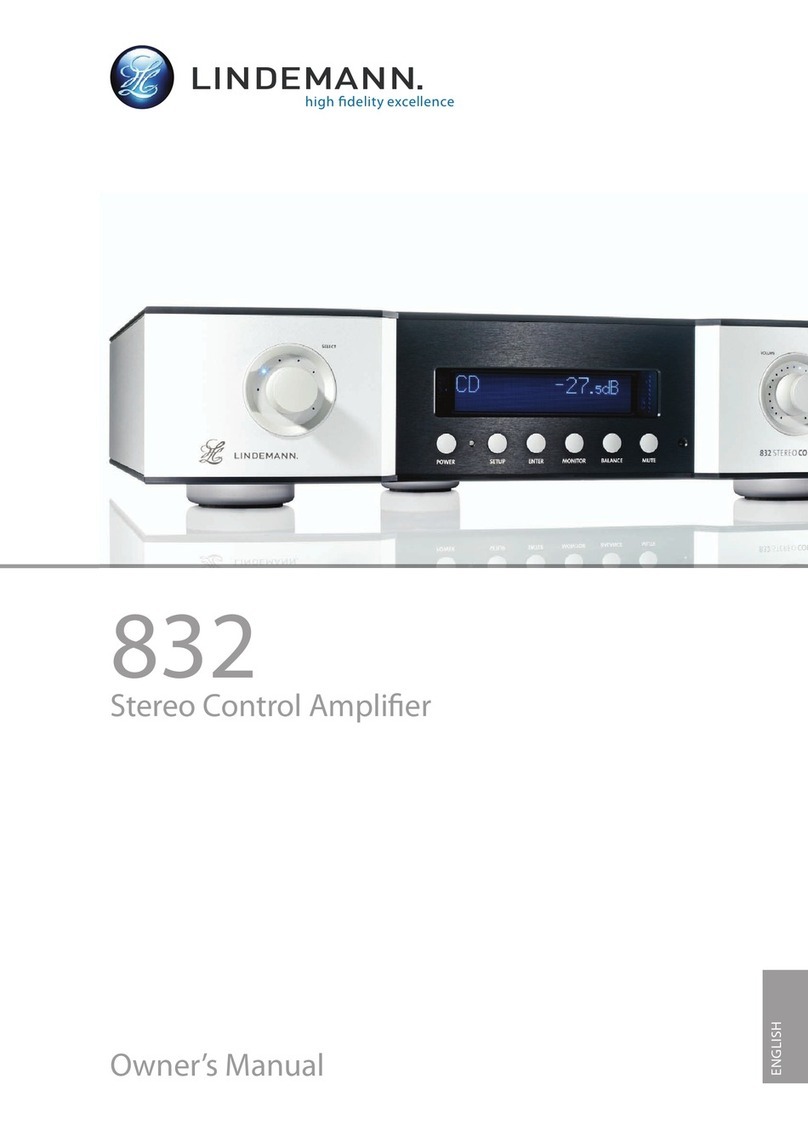
Lindemann
Lindemann 832 User manual
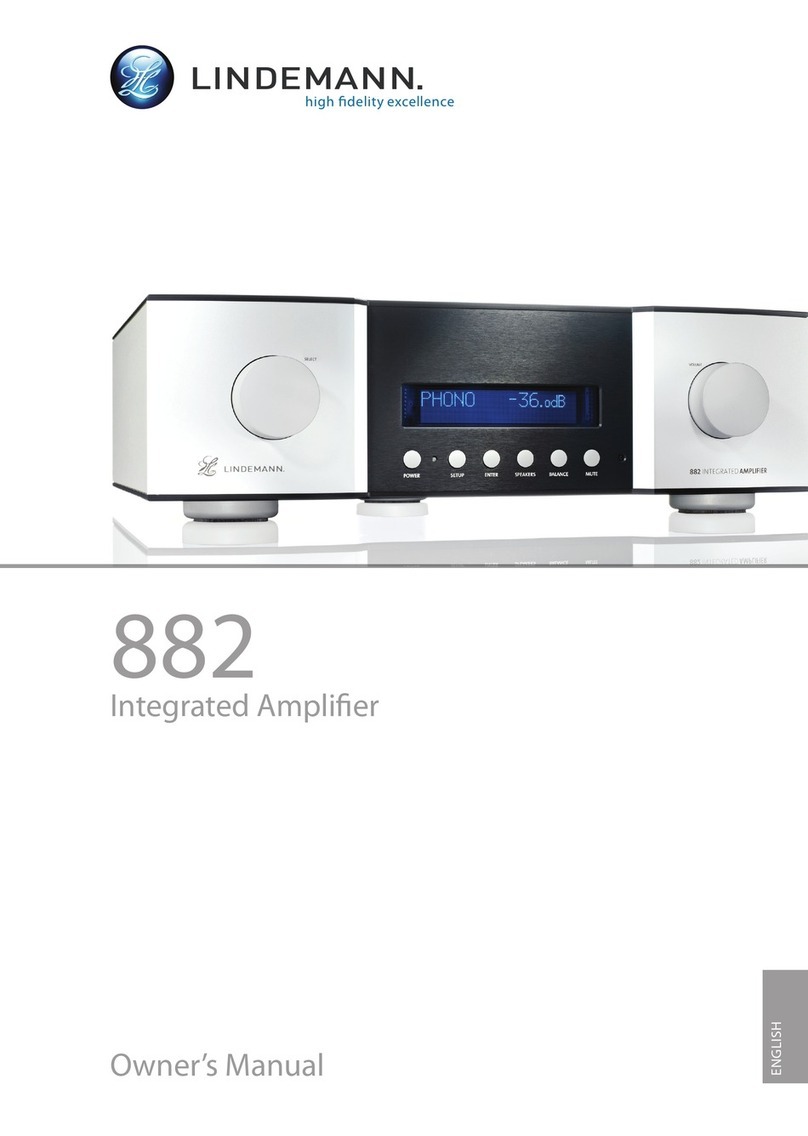
Lindemann
Lindemann 882 User manual

Lindemann
Lindemann Limetree Headphone User manual
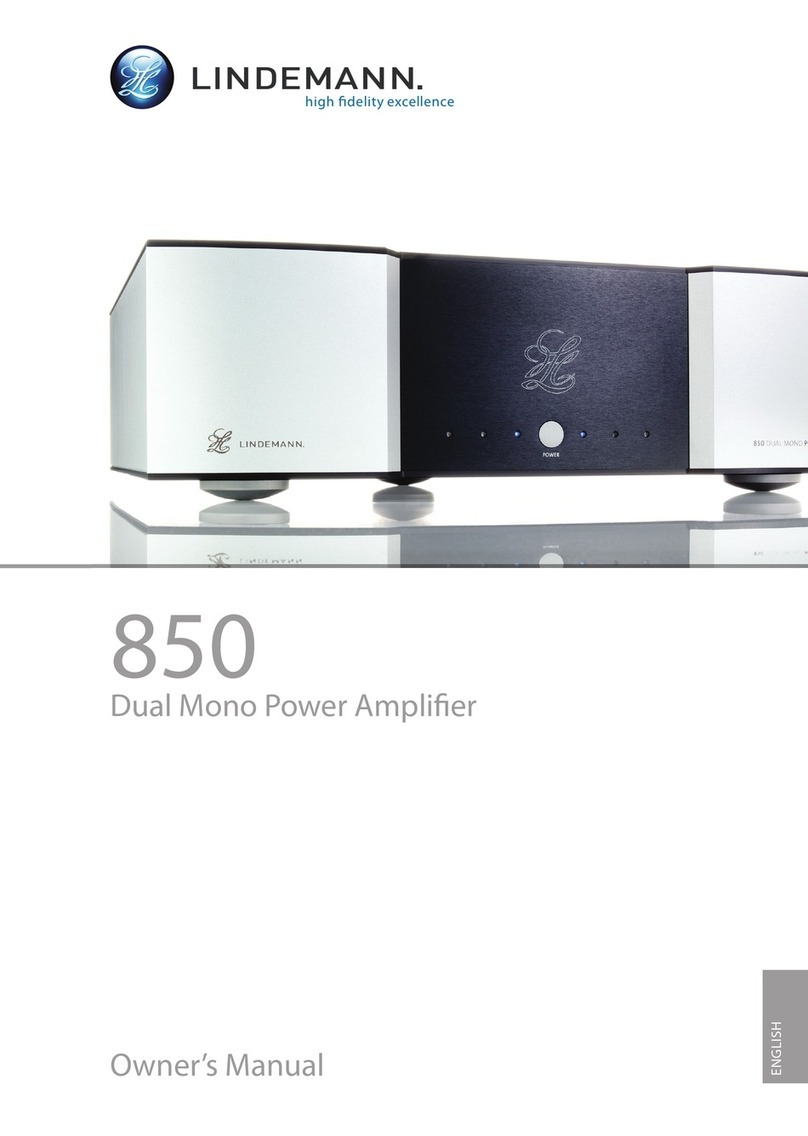
Lindemann
Lindemann 850 User manual
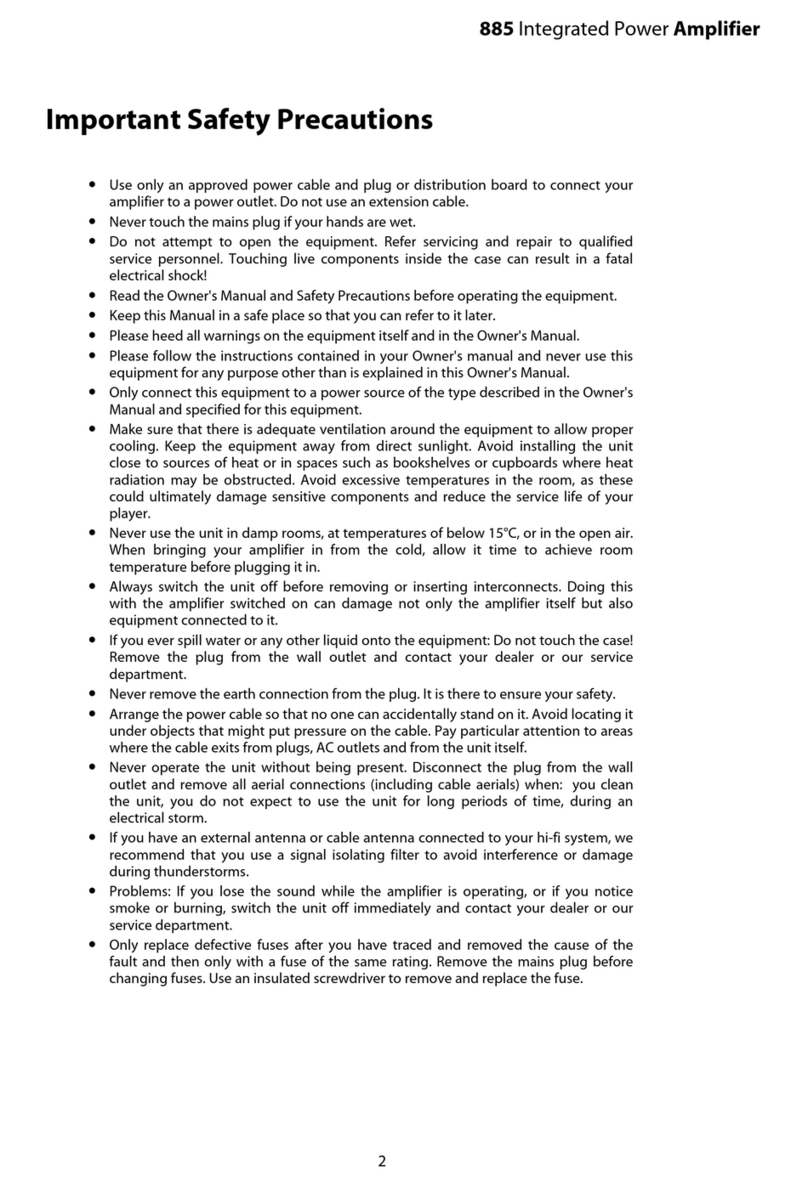
Lindemann
Lindemann 885 User manual
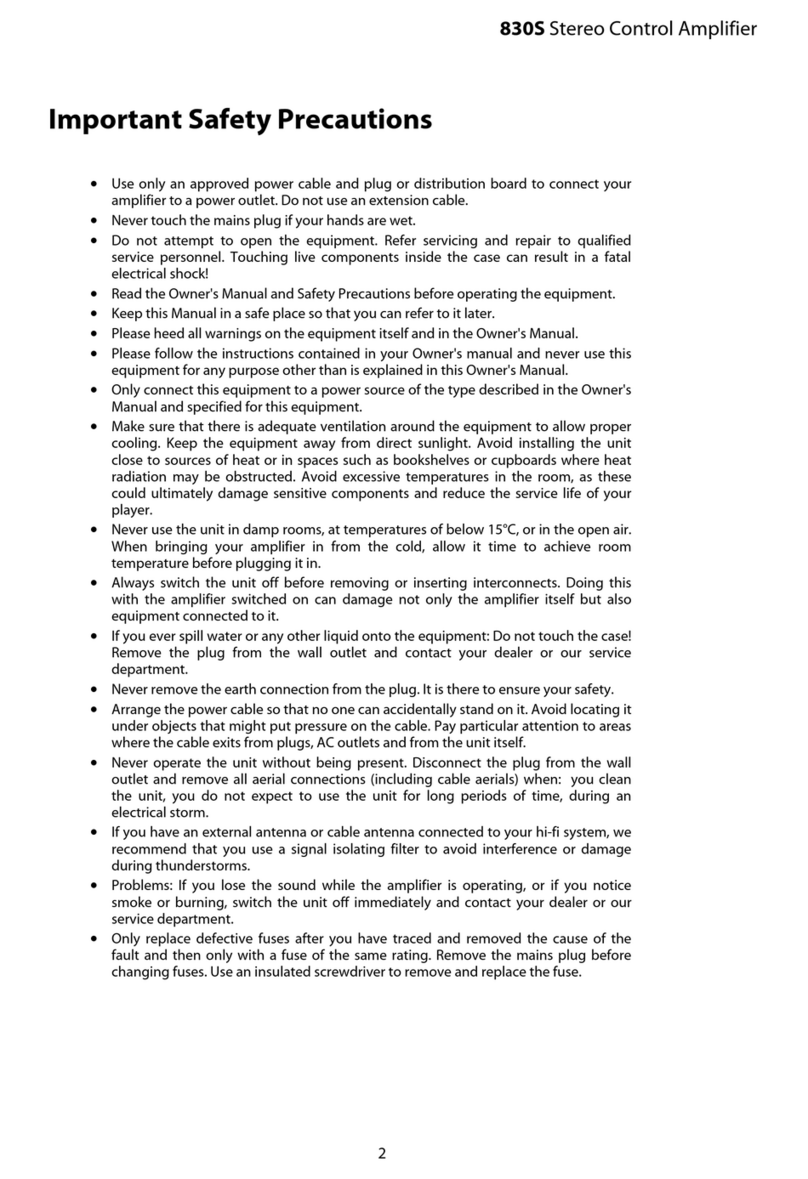
Lindemann
Lindemann 830S User manual
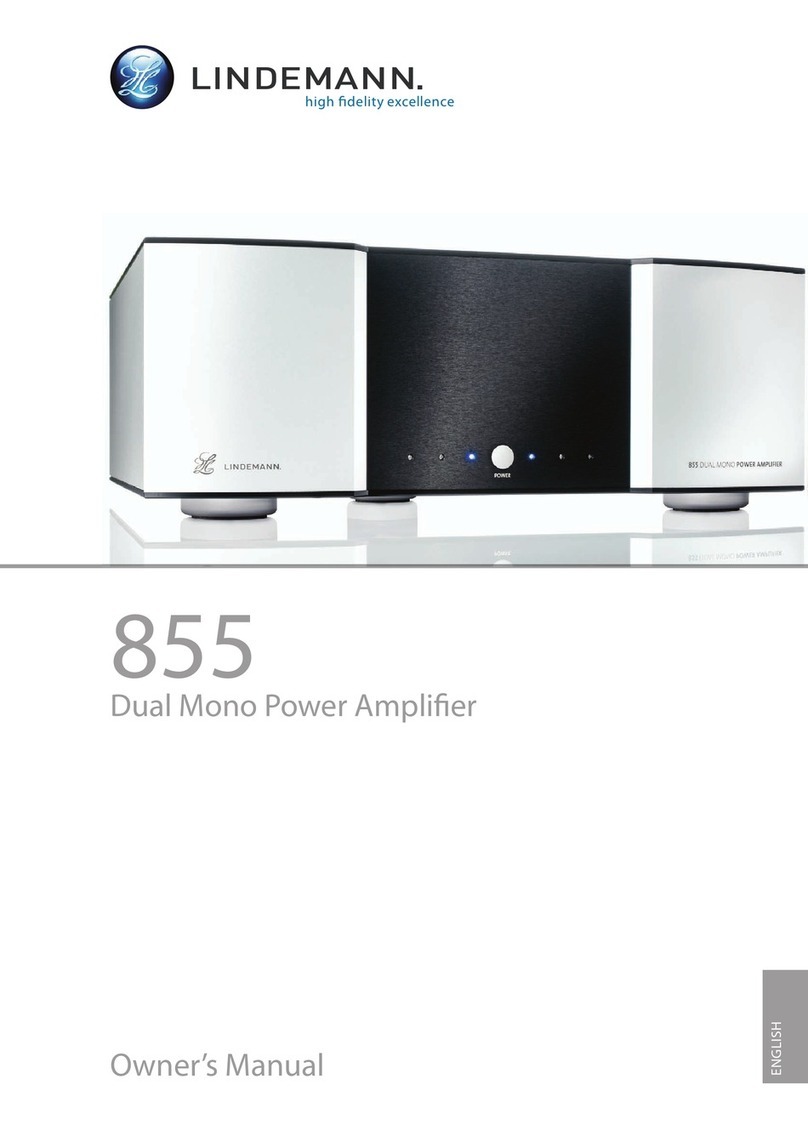
Lindemann
Lindemann 855 User manual

Lindemann
Lindemann musicbook 50 User manual
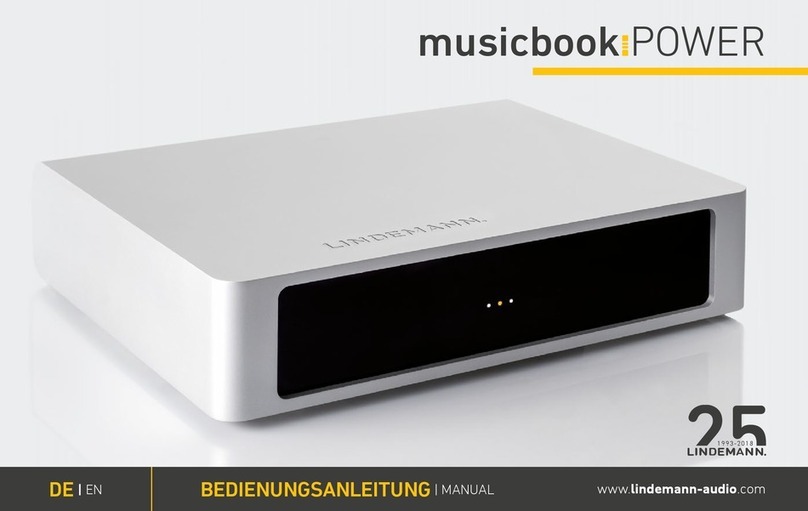
Lindemann
Lindemann musicbook Power Series User manual
Popular Amplifier manuals by other brands
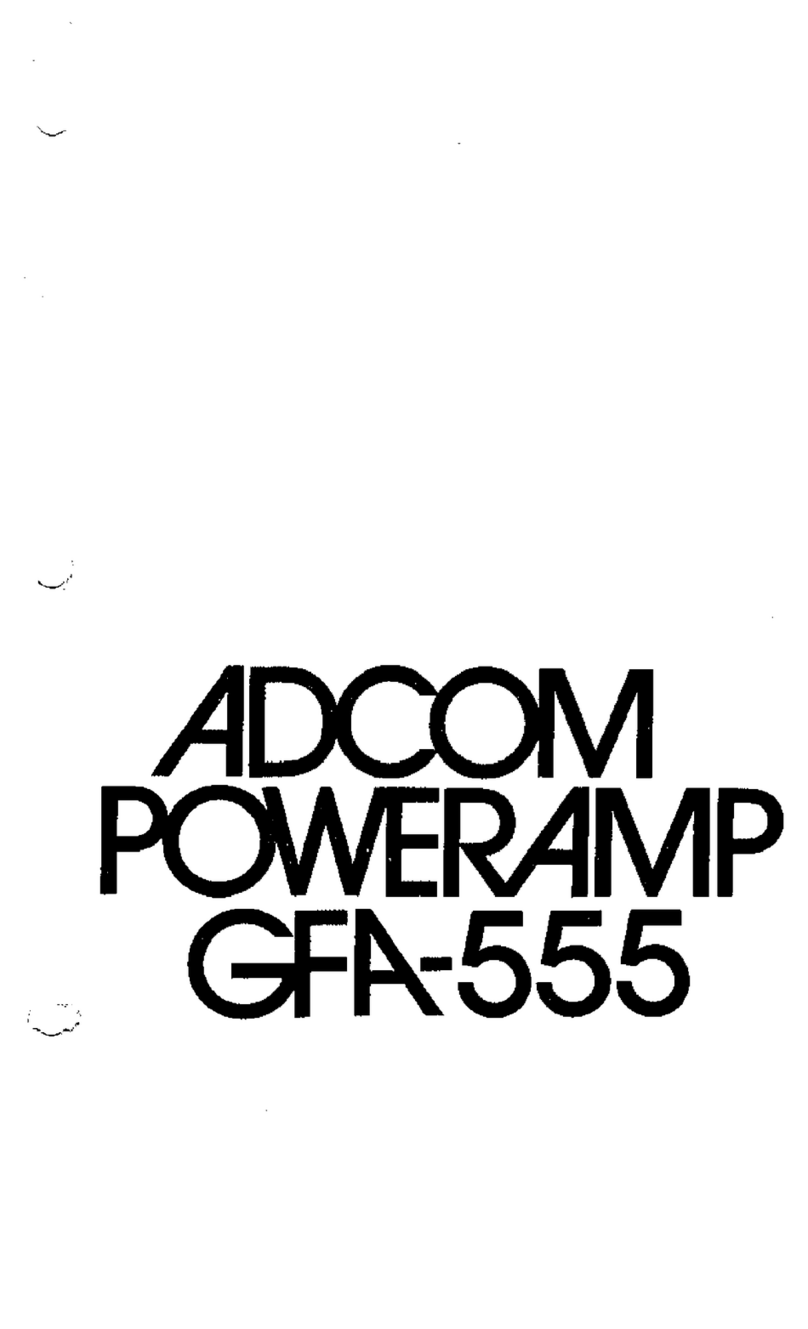
Adcom
Adcom GFA-555 owner's manual
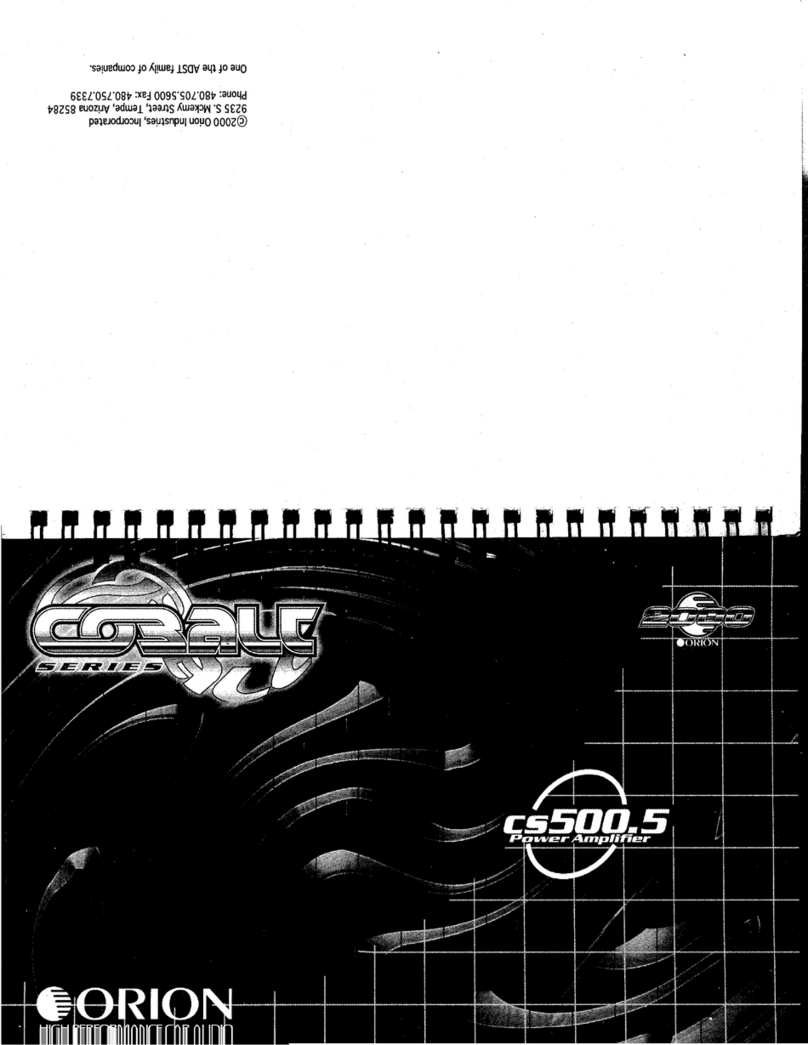
Orion
Orion Corale Series CS500.5 product manual

Alpha MED Scientific
Alpha MED Scientific MED-A64MD1A product manual
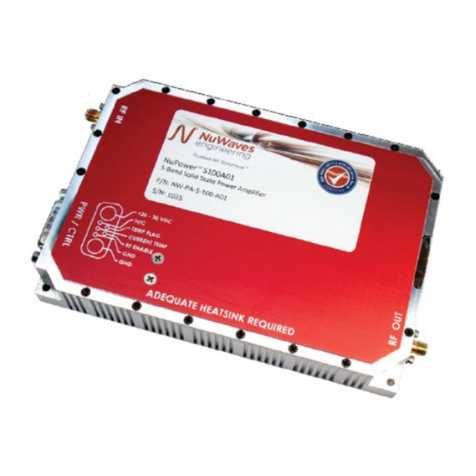
NuWaves
NuWaves NUPOWER S100A01 user manual
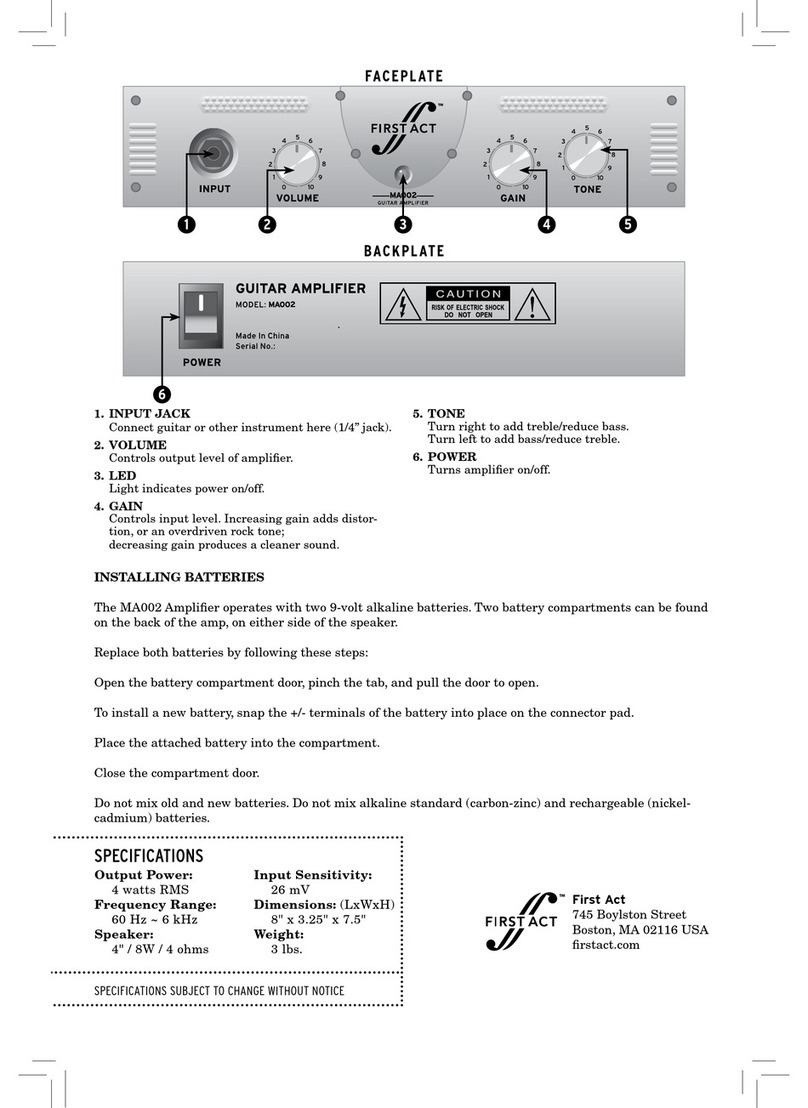
First Act
First Act Amplifier MA002 instruction manual
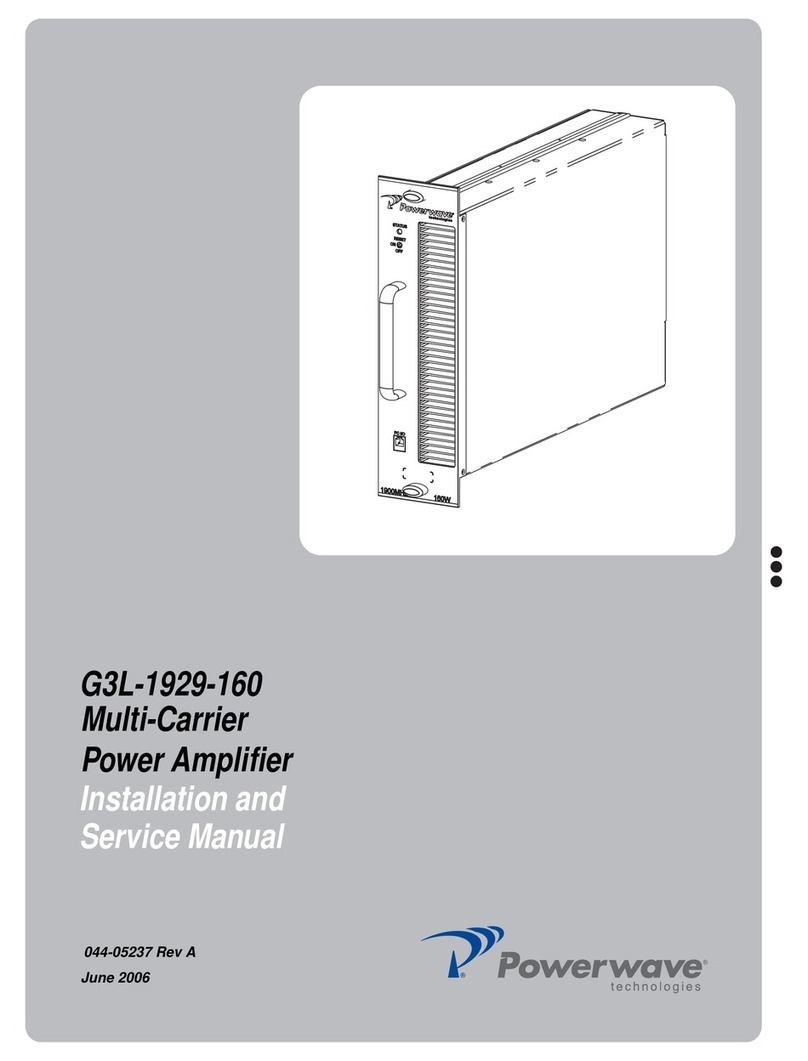
PowerWave
PowerWave G3L-1929-160 Installation and service manual
